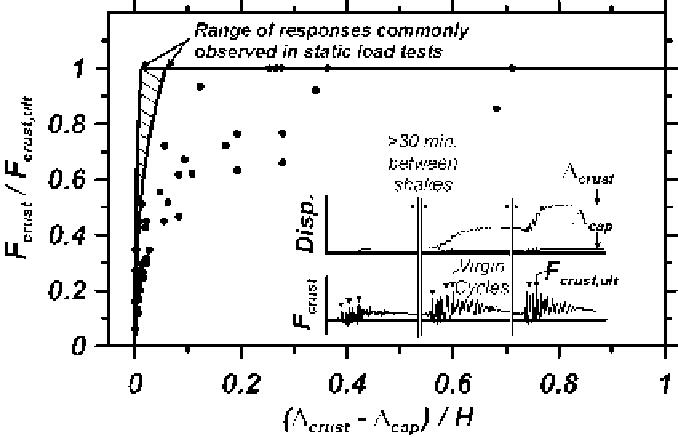Geoscience Reference
In-Depth Information
not available, so for simplicity, the p-multipliers may be assumed to characterize the
effects of liquefaction on t-zand q-z behavior as well.
Proceduresforestimatingtheultimatelateralloadsimposedbyaclaycrustagainstapile
cap were evaluated using dynamic centrifuge model data (e.g., Figure 12.2). Conven-
tionalearthpressuretheorieswerecapableofreasonablyestimatingthepeakcrustloads,
provided that the frictional resistance along the pile-cap sides and along a portion of the
pile-cap base were included (Brandenberg et al.,2005, 2007b).
Load transfer between the nonliquefied crust and the pile cap is affected by the occur-
rence of liquefaction. Brandenberg et al. (2005) developed backbone relationships for
the load transfer between pile groups and free-field nonliquefied crusts using the virgin
peaks in the dynamic loads observed during centrifuge tests, as shown in Figure 12.6.
The backbone relationships were about an order of magnitude softer than the relation-
ships that have been obtained from static load tests in nonliquefied ground. The softer
loadtransferbehaviorisattributedto:(1)liquefactionoftheunderlyingsandlayerwhich
caused the interaction stresses between the crust and pile cap to be distributed through-
out a larger zone of influence in the crust, thereby requiring the development of larger
relative displacements to reach a given load level and (2) the combined effects of cyclic
degradationandcrackinginthenonliquefiedcrust.Asimpleanalyticalmodelforthefor-
mer mechanism is illustrated in Figure 12.7, while more complete models are presented
in Brandenberg et al. (2007b).
Fig. 12.6. Backbone load transferrelationships between a laterally spreading clay crust
and a pile cap from five centrifuge tests

